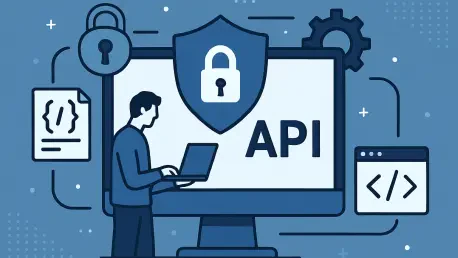In today’s increasingly interconnected digital landscape, APIs serve as the backbone of countless applications, from mobile banking apps to sprawling enterprise systems, making their security paramount. Imagine a scenario where a single unsecured API endpoint exposes sensitive customer data to malicious actors, leading to a breach that costs a company millions in fines and lost trust. This is not a far-fetched nightmare but a reality faced by organizations that overlook API security. With APIs facilitating critical data exchanges and system integrations, securing them is no longer optional but a fundamental necessity for developers. This guide aims to equip developers with actionable strategies to design APIs that withstand threats and protect both systems and users.
The purpose of this how-to guide is to provide a clear roadmap for building secure APIs by focusing on essential practices that address common vulnerabilities. It delves into the importance of robust security measures in an era where data breaches can devastate reputations and finances. By following the detailed steps and strategies outlined, developers can create APIs that not only function efficiently but also stand as fortified gateways against exploitation. The guide covers critical areas such as authentication, rate limiting, input validation, and versioning, ensuring a comprehensive approach to API security.
This guide is structured to walk through each strategy with precision, offering practical advice and tools to implement security at every stage of API development. It addresses the growing threat landscape and provides insights into why proactive measures are vital for maintaining user trust. Developers will find step-by-step instructions tailored to modern challenges, ensuring that security is embedded into the core of their API design process. Let’s dive into the methodologies that can transform an API from a potential liability into a secure asset.
Why API Security Matters in a Connected World
APIs are the linchpins of modern software ecosystems, enabling seamless communication between mobile applications, web platforms, and microservices architectures. They power everything from real-time payment processing to social media integrations, making them indispensable in today’s tech-driven environment. However, this pervasive reliance also positions APIs as prime targets for cyberattacks, where a single flaw can unravel an entire system’s integrity.
The risks of insecure APIs are profound, ranging from data breaches that expose personal information to system overloads caused by malicious exploitation, such as distributed denial-of-service attacks. Such incidents not only lead to financial losses but also erode user confidence, which can be nearly impossible to rebuild. Developers must recognize that neglecting security can transform an API from a tool of efficiency into a gateway for disaster.
Security must therefore be treated as a core design principle rather than an afterthought in API development. By prioritizing protective measures from the outset, developers can mitigate risks and ensure reliable performance under pressure. This guide will explore key strategies, including robust authentication, effective rate limiting, thorough input validation, and strategic API versioning, to help create APIs that stand firm against evolving threats.
The Growing Threat Landscape of API Vulnerabilities
The reliance on APIs for data exchange and system integration has surged, with businesses increasingly adopting cloud-based solutions and interconnected services. This expansion, while beneficial for scalability and innovation, has also broadened the attack surface for cybercriminals. APIs often handle sensitive information, making them attractive entry points for unauthorized access and exploitation.
Common vulnerabilities in APIs include weak authentication mechanisms that fail to verify user identity, absence of rate limiting that allows resource abuse, and inadequate input handling that invites injection attacks. These flaws are frequently exploited due to oversight or rushed development cycles, leaving systems exposed to threats that could have been prevented with proper safeguards. Real-world examples, such as high-profile breaches where attackers gained access through poorly secured API endpoints, underscore the devastating consequences of such lapses.
Given these stakes, developers must prioritize security to protect users and sustain trust in their applications. A proactive approach to identifying and addressing vulnerabilities ensures that APIs remain reliable conduits for data rather than liabilities. Adopting a security-first mindset is not just a technical requirement but a commitment to safeguarding the digital interactions that define modern business and personal connectivity.
Core Strategies for Building Secure APIs
Strategy 1: Implementing Robust Authentication
Authentication serves as the first line of defense in controlling access to an API, ensuring that only authorized entities can interact with sensitive resources. Without a strong authentication framework, APIs are vulnerable to unauthorized access, which can lead to data theft or manipulation. Establishing this barrier is crucial for maintaining the integrity of any system reliant on API interactions.
Developers can choose from several authentication methods depending on the use case, such as API keys for internal or low-risk scenarios, JSON Web Tokens (JWT) for stateless user sessions, and OAut## for secure third-party integrations. Each method offers distinct advantages, with JWT providing a compact, verifiable token system and OAut## enabling delegated access without exposing credentials. Selecting the appropriate mechanism based on the API’s exposure and sensitivity is a foundational step in security design.
Best Practices for Token Security
To maximize the effectiveness of token-based authentication, developers should employ strong signing keys for JWTs and enforce short expiry times to limit the window of potential misuse. These measures reduce the risk of compromised tokens being used indefinitely. Additionally, ensuring that tokens are validated server-side on every request prevents client-side tampering from bypassing security checks.
Token rotation and secure storage mechanisms are equally vital to maintaining a secure authentication process. Regularly refreshing tokens and storing them in protected environments, such as encrypted databases, minimizes exposure to theft or interception. These practices create a dynamic security layer that adapts to potential threats over time.
Ensuring Secure Transmission
Transmitting authentication data over unsecured channels can render even the strongest tokens useless, as attackers can intercept sensitive information. Mandating the use of HTTPS for all API communications ensures that data, including tokens, is encrypted during transit. This step is non-negotiable for preventing man-in-the-middle attacks and preserving confidentiality.
Strategy 2: Enforcing Rate Limiting to Prevent Abuse
Rate limiting acts as a critical mechanism to control the volume of requests an API receives, safeguarding against abuse and denial-of-service attacks that can cripple system performance. By setting boundaries on how often a user or client can interact with an endpoint, developers can maintain stability and ensure fair resource allocation. This control is essential for both security and operational efficiency.
Unregulated access can lead to severe consequences, including server overloads that disrupt service for legitimate users or exploitation by bots attempting to harvest data. Rate limiting mitigates these risks by capping request frequencies, thereby protecting backend infrastructure from being overwhelmed. Implementing this strategy is a proactive way to balance accessibility with protection.
Steps to Set Up Effective Rate Limiting
- Choose a Rate-Limiting Mechanism: Select a suitable algorithm such as fixed window, sliding window, or token bucket based on the API’s requirements. Fixed window is simple to implement but may allow bursts at window boundaries, while token bucket offers smoother control over request flow.
- Identify Tracking Criteria: Determine the identifier for tracking limits, such as IP address for broad control, user ID for personalized restrictions, or access token for client-specific monitoring. This choice impacts how granular the rate limiting will be.
- Leverage Appropriate Tools: Utilize libraries like express-rate-limit for Node.js environments or Redis for distributed systems to enforce limits across multiple instances. Cloud-native solutions, such as AWS API Gateway throttling, can also simplify implementation in scalable setups.
Configuring Limits and Responses
Setting practical thresholds, such as allowing 100 requests per 15 minutes per user, helps balance usability with security, preventing abuse without overly restricting legitimate activity. These limits should be tailored to the API’s purpose and expected traffic patterns. Testing different thresholds during development can reveal the optimal configuration for specific use cases.
When limits are exceeded, returning standardized HTTP 429 (Too Many Requests) status codes with Retry-After headers provides clarity to clients on when they can attempt access again. This transparency aids in managing user expectations and encourages adherence to rate policies. Logging such events also enables monitoring for unusual patterns that might indicate malicious intent.
Strategy 3: Validating Input to Block Malicious Data
Untrusted input poses a significant threat to APIs, as it can lead to injection attacks like SQL or command injection, as well as system crashes from malformed data. Every piece of incoming data, regardless of its origin, must be treated with suspicion to prevent exploitation. Rigorous validation is a non-negotiable aspect of secure API design that cannot be overlooked.
Failing to sanitize or validate input can open doors to attackers who manipulate data to execute unauthorized actions or disrupt services. Such vulnerabilities often stem from assumptions that clients will always send benign requests, a risky stance in today’s threat environment. Developers must adopt a defensive posture to neutralize these potential attack vectors effectively.
Using Schema-Based Validation Tools
Employing schema-based validation libraries, such as Pydantic for Python or JSR 380 for Java, allows developers to enforce strict data structures and reject non-conforming inputs. These tools enable the definition of expected data types, required fields, and acceptable formats, creating a robust filter against malicious or erroneous data. Integrating such libraries into the API pipeline ensures consistency in validation efforts.
Preventing Unexpected Data
Beyond defining schemas, rejecting unforeseen attributes in requests is a critical step to avoid processing unintended data that could exploit system weaknesses. Any input that deviates from the defined structure should be discarded rather than processed. Additionally, logging suspicious or rejected inputs provides valuable insights for monitoring and refining security measures over time.
Strategy 4: Planning for Change with API Versioning
APIs are not static; they evolve with new features, bug fixes, and changing requirements, often introducing breaking changes that can disrupt client applications. Without a strategy to manage these updates, developers risk alienating users or forcing abrupt transitions that compromise functionality. Planning for change is a forward-thinking approach to API maintenance.
Versioning offers a solution by allowing multiple API iterations to coexist, ensuring backward compatibility for existing clients while introducing improvements for new ones. Explicit versioning from the project’s inception prevents confusion and maintains a stable contract for integration. This practice is essential for long-term API sustainability in dynamic environments.
Versioning Techniques for Stability
Adopting URI-based versioning, such as structuring endpoints as /api/v1/resource, provides clear delineation between API versions for both developers and clients. This method is intuitive and widely understood, facilitating straightforward implementation. Alternatively, header-based versioning offers flexibility by allowing version specification in request headers, catering to more complex use cases.
Communicating Changes to Users
Effective communication is key to smooth transitions during version updates, requiring detailed documentation of deprecation timelines for older versions. Providing migration guides helps clients adapt to new versions at their own pace, reducing friction. Transparent announcements about upcoming changes further build trust and prepare users for necessary adjustments.
Quick Recap of Essential API Security Tactics
This section summarizes the core strategies for securing APIs in a concise format for quick reference:
- Strengthen access control by implementing secure authentication methods like JWT and OAut## to verify identities.
- Protect system resources through rate limiting, setting thresholds to manage load and deter abuse effectively.
- Guard against malicious inputs by validating all data using schema-based tools to enforce structure and safety.
- Future-proof APIs with versioning strategies to handle updates gracefully and maintain client compatibility.
These practices must be integrated into the development lifecycle from the outset to ensure consistent security. Embedding them into design and testing phases creates a resilient foundation. Developers are encouraged to revisit these tactics regularly to adapt to new challenges.
The Bigger Picture: API Security in an Evolving Digital Era
Secure API design aligns closely with broader technological trends, such as the widespread adoption of cloud computing and microservices architectures. These paradigms rely heavily on APIs for seamless interoperability, amplifying the need for robust security to protect distributed systems. Understanding this context helps developers appreciate the strategic importance of their security efforts.
Emerging challenges, such as securing APIs in serverless environments or Internet of Things ecosystems, add layers of complexity to traditional security models. These environments often involve transient resources or constrained devices, requiring tailored approaches to authentication and data protection. Staying ahead of these issues demands continuous learning and adaptation to novel architectures.
Developers play a pivotal role in keeping pace with new threats and evolving security standards, ensuring that their APIs remain resilient. The future may see greater adoption of standardized API security frameworks and automated testing tools to streamline protection efforts. Embracing these advancements will be crucial for maintaining secure and innovative API ecosystems in the years ahead.
Final Thoughts: Building Trust Through Secure API Design
Reflecting on the journey through secure API design, the commitment to robust practices has proven to be an ongoing responsibility rather than a one-time effort. Developers who have embraced authentication, rate limiting, input validation, and versioning as integral components of their workflow have built APIs that users can rely on. This dedication has laid the groundwork for trust in digital interactions.
Moving forward, the focus should shift to regular audits of existing APIs to uncover hidden vulnerabilities or outdated practices. Staying informed about emerging threats through industry updates or security communities has equipped developers to anticipate and counter risks proactively. This vigilance has ensured that APIs remain secure gateways rather than points of failure.
As a next step, developers are encouraged to explore advanced security tools and collaborate with peers to share insights on evolving challenges. Experimenting with automated security testing or integrating real-time monitoring has offered additional layers of protection. By continuing to prioritize security with the same diligence as functionality, developers have contributed significantly to a safer digital landscape for all.









